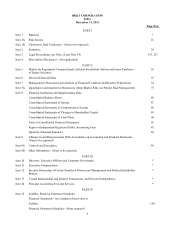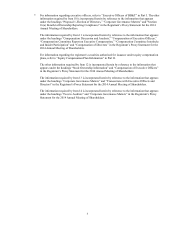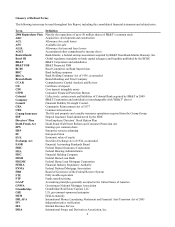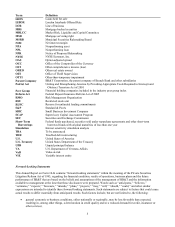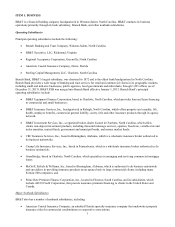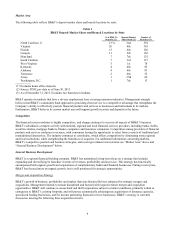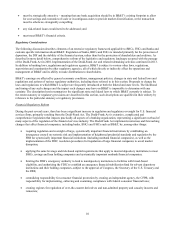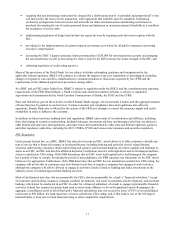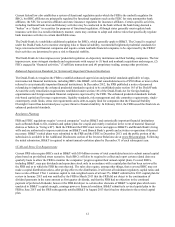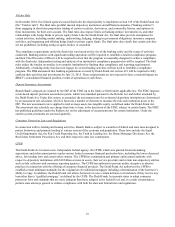BB&T 2013 Annual Report Download - page 10
Download and view the complete annual report
Please find page 10 of the 2013 BB&T annual report below. You can navigate through the pages in the report by either clicking on the pages listed below, or by using the keyword search tool below to find specific information within the annual report.
10
must be strategically attractive – meaning that any bank acquisition should be in BB&T’s existing footprint to allow
for cost savings and economies of scale or in contiguous states to provide market diversification, or the transaction
must be otherwise strategically compelling;
any risk-related issues would need to be addressed; and
must meet BB&T’s financial criteria.
Regulatory Considerations
The following discussion describes elements of an extensive regulatory framework applicable to BHCs, FHCs and banks and
contains specific information about BB&T. Regulation of banks, BHCs and FHCs is intended primarily for the protection of
depositors, the DIF and the stability of the financial system, rather than for the protection of shareholders and creditors. As
described in more detail below, comprehensive reform of the legislative and regulatory landscape occurred with the passage
of the Dodd-Frank Act in 2010. Implementation of the Dodd-Frank Act and related rulemaking activities continued in 2013.
In addition to banking laws, regulations and regulatory agencies, BB&T is subject to various other laws, regulations,
supervision and examination by other regulatory agencies, all of which directly or indirectly affect the operations and
management of BB&T and its ability to make distributions to shareholders.
BB&T’s earnings are affected by general economic conditions, management policies, changes in state and federal laws and
regulations and actions of various regulatory authorities, including those referred to in this section. Proposals to change the
laws and regulations to which BB&T is subject are frequently introduced at both the federal and state levels. The likelihood
and timing of any such changes and the impact such changes may have on BB&T is impossible to determine with any
certainty. The description herein summarizes the significant state and federal laws to which BB&T currently is subject. To
the extent statutory or regulatory provisions are described in this section, such descriptions are qualified in their entirety by
reference to the particular statutory or regulatory provisions.
Financial Regulatory Reform
During the past several years, there has been a significant increase in regulation and regulatory oversight for U.S. financial
services firms, primarily resulting from the Dodd-Frank Act. The Dodd-Frank Act is extensive, complicated and
comprehensive legislation that impacts practically all aspects of a banking organization, representing a significant overhaul of
many aspects of the regulation of the financial services industry. The Dodd-Frank Act implements numerous and far-reaching
changes that affect financial companies, including banks, BHCs and FHCs such as BB&T, by, among other things:
requiring regulation and oversight of large, systemically important financial institutions by establishing an
interagency council on systemic risk and implementation of heightened prudential standards and regulation by the
FRB for systemically important financial institutions (including nonbank financial companies), as well as the
implementation of the FDIC resolution procedures for liquidation of large financial companies to avoid market
disruption;
applying the same leverage and risk-based capital requirements that apply to insured depository institutions to most
BHCs, savings and loan holding companies and systemically important nonbank financial companies;
limiting the FRB’s emergency authority to lend to nondepository institutions to facilities with broad-based
eligibility, and authorizing the FDIC to establish an emergency financial stabilization fund for solvent depository
institutions and their holding companies, subject to the approval of Congress, the Secretary of the U.S. Treasury and
the FRB;
centralizing responsibility for consumer financial protection by creating an independent agency, the CFPB, with
responsibility for implementing, enforcing and examining compliance with federal consumer financial laws;
creating regimes for regulation of over-the-counter derivatives and non-admitted property and casualty insurers and
reinsurers;


